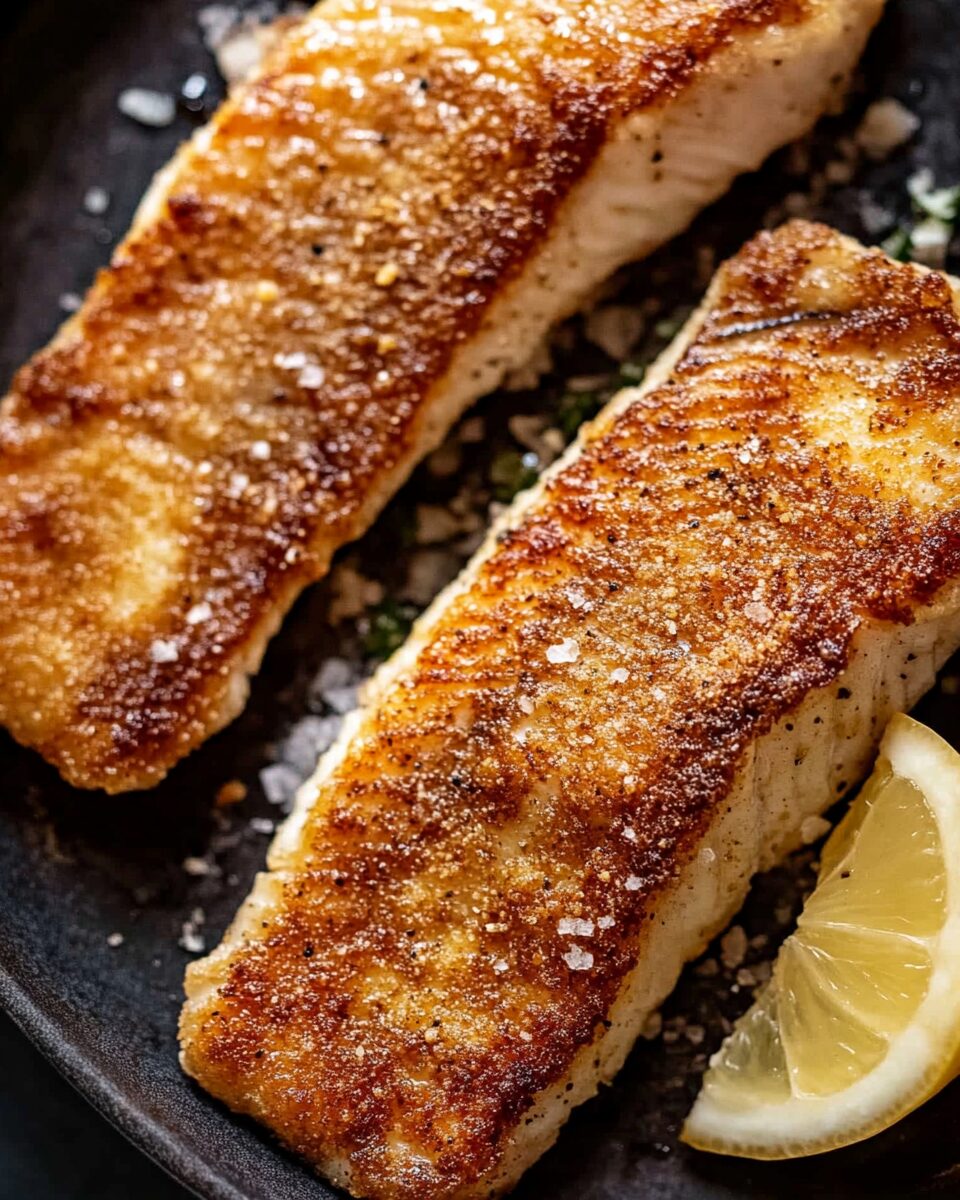The beauty of this crispy skin barramundi lies in its simplicity and elegance. With just a few pantry staples and a quality fillet, you can achieve restaurant-level results at home. The contrast of the glassy, golden skin with the moist, flaky flesh beneath is an absolute delight.
This technique works beautifully with many types of fish, making it a foundational method worth mastering. Whether paired with creamy risotto, lentils, or a velvety sauce, this dish elevates any meal into a refined culinary experience. Quick enough for a weeknight, yet elegant enough for guests—this is seafood done right.
Full Recipe:
-
2 x 180g (6 oz) barramundi fillets, skin on, pin-boned and scaled
-
2 tablespoons olive oil (or any high-smoke-point oil like canola or grapeseed)
-
3/4 teaspoon kosher salt
-
1/4 teaspoon freshly ground black pepper
Optional serving suggestions:
-
French Lentil Ragout
-
Lemon Herb Risotto
-
Pea Puree
-
Lemon Butter Sauce or Garlic Butter
Directions:
-
Preheat oven to 200°C/390°F (180°C fan) if using thick fillets (>2.5 cm or 1 inch thick).
-
Dry the fish skin thoroughly with paper towels. For extra crispiness, place uncovered in the fridge skin side up for 1 hour prior (optional).
-
Score the skin of thick fillets by making shallow cuts (4cm long, 1cm apart, 2–3mm deep) with a sharp knife to prevent curling and ensure even cooking.
-
Season both skin and flesh sides of the fillets with salt and pepper just before cooking.
-
Heat oil in a non-stick, oven-safe pan over medium-high heat until shimmering and just starting to smoke.
-
Place fillets skin-side down, then press lightly with a spatula for 10 seconds to seal the skin flat against the pan.
-
Cook skin-side down for 2–3 minutes, until golden and crisp.
-
If using thick fillets, transfer the pan to the oven without flipping and bake for 10 minutes, or until internal temperature reaches 55°C / 131°F.
-
Remove fish and let rest skin-side up on a rack for 3 minutes.
-
Serve skin-side up, optionally pairing with lentils, risotto, or a light butter sauce. Pour any sauce only just before serving to preserve crispiness.
Prep Time: 5 minutes | Cooking Time: 13 minutes | Total Time: 18 minutes
Kcal: 266 kcal | Servings: 2
The Art of Cooking Crispy Skin Barramundi
Achieving a perfectly crispy skin on fish is a culinary skill that instantly elevates a simple seafood dish into a gourmet experience. In particular, barramundi—a favorite fish in Australian cuisine—is known for its moist, flaky interior and skin that crisps up like golden glass when prepared correctly. This dish is not only delicious but also showcases the precision, patience, and technique that define great cooking.
Crispy skin barramundi is loved for the beautiful texture contrast it offers: the brittle crackle of the skin juxtaposed with the tender and succulent flesh underneath. It’s a dish that, once mastered, becomes a go-to recipe for impressing guests or indulging in a refined meal at home. The best part? It’s far more accessible than it sounds.
Why Barramundi?
Barramundi is an iconic fish in Australian waters, prized for its buttery texture, clean flavor, and versatility in the kitchen. Its skin crisps beautifully when seared properly, and it doesn’t have an overly “fishy” taste, making it a great choice even for those who are tentative about seafood. It’s also widely available in supermarkets and fishmongers, both fresh and frozen, making it a practical choice for home cooks.
In terms of nutrition, barramundi is rich in protein and low in fat, with a healthy dose of omega-3 fatty acids. This makes it not only a tasty option but also a heart-healthy one. Whether served over lentils, risotto, or accompanied by a tangy citrus sauce, it remains the star of any plate it graces.
What Makes the Skin Crispy?
The key to perfecting crispy skin lies in understanding the interaction between heat, moisture, and fat. Moisture is the enemy of crispiness, so drying the skin thoroughly is non-negotiable. For best results, pat the skin dry with paper towels and, if time allows, leave the fillets uncovered in the refrigerator for about an hour to draw out even more moisture.
The pan must be hot—really hot—before the fish hits it. Look for shimmering oil and the first wisps of smoke before you place the fillet skin-side down. This immediate high heat helps the skin to “set” against the pan, sealing in the crispness. Pressing the fish down gently for the first 10 seconds of cooking ensures maximum surface contact, preventing the skin from curling and promoting even browning.
Interestingly, the use of butter is discouraged for achieving crispy skin due to its water content. Instead, neutral oils like olive, canola, or grapeseed are preferred. Ghee or clarified butter, which lacks water, can be used for additional flavor without compromising texture.
The Importance of Scoring the Skin
Scoring the skin—cutting shallow slits across it—serves a dual purpose. First, it allows the skin to remain flat during cooking, minimizing the curling that can occur due to heat-induced contraction. Second, it promotes more even cooking of the flesh, especially in thicker fillets.
Scoring may seem like a small step, but it has a noticeable effect on the final presentation and mouthfeel of the dish. When done right, the slits become subtle aesthetic touches that blend into the crackled surface of the golden skin.
Serving Suggestions to Complement Crispy Skin Fish
When it comes to serving crispy skin barramundi, simplicity and elegance go hand in hand. The fish is the star, so sides should complement rather than compete. Saucy sides are highly recommended, as they serve both as an accompaniment and a subtle sauce to balance the texture.
A French lentil ragout is a perfect match, offering earthy depth and a creamy texture that contrasts beautifully with the crisp fish skin. A no-stir lemon herb risotto adds brightness and comfort, while a smooth pea puree provides a pop of color and gentle sweetness.
For sauces, avoid anything too heavy or overpowering. Lemon butter, garlic herb sauces, or a light dill cream add moisture and flavor without masking the barramundi’s delicate taste. Whatever you choose, always pour the sauce around or underneath the fish—not on top of the skin—until the last possible second to preserve its crispness.
Tips for Success
1. Use a Non-Stick or Cast-Iron Pan: These pans conduct heat well and reduce the chances of the skin sticking, which can ruin both texture and appearance.
2. Don’t Move the Fish: Once placed in the pan, let the fish cook undisturbed for a few minutes. Moving it too soon can tear the skin and prevent even crisping.
3. Rest Before Serving: Just like with steak, letting the fish rest allows the juices to redistribute throughout the flesh. This ensures every bite is juicy and flavorful.
4. Serve Skin Side Up: Always present the fish skin-side up on the plate to showcase that beautiful golden layer and to keep it from getting soggy on contact with moisture.
5. Mind the Thickness: Thicker fillets benefit from finishing in the oven, ensuring the interior cooks through without overcooking the exterior. Thin fillets can be cooked entirely on the stovetop.
Common Mistakes to Avoid
-
Using Cold Fish: Let the fish come to room temperature for about 15–20 minutes before cooking. This promotes even cooking and better texture.
-
Overcrowding the Pan: Cook in batches if necessary. Overcrowding lowers the pan’s temperature, leading to steaming rather than searing.
-
Seasoning Too Early: Salt draws moisture out of the fish, so season right before it goes into the pan.
-
Pouring Sauce Over the Skin: Doing this prematurely softens the skin. Instead, spoon sauces around the fish on the plate.
Why This Recipe is a Must-Try
Whether you’re a seasoned chef or an adventurous home cook, mastering crispy skin barramundi opens the door to countless elegant, healthy, and deeply satisfying meals. It’s fast—ready in under 20 minutes—yet feels indulgent and refined. Perfect for weeknight dinners or special occasions alike, it strikes the perfect balance between flavor, texture, and nutritional value.
The minimal ingredient list keeps the focus on technique, encouraging culinary growth with every cook. Plus, the versatility of this method means it can be applied to many types of fish, from snapper and trout to cod and ocean perch.
Conclusion
Crispy skin barramundi is more than just a dish—it’s a celebration of texture and technique. With a few key principles and a little attention to detail, you can transform a humble fillet into a restaurant-worthy entrée. It’s a brilliant example of how mastering a fundamental cooking method can elevate your entire culinary repertoire.
Whether you’re hosting guests, cooking for loved ones, or just treating yourself to something special, this recipe delivers every time. Crispy, flavorful, and effortlessly elegant—it’s a fish dish you’ll come back to again and again.






